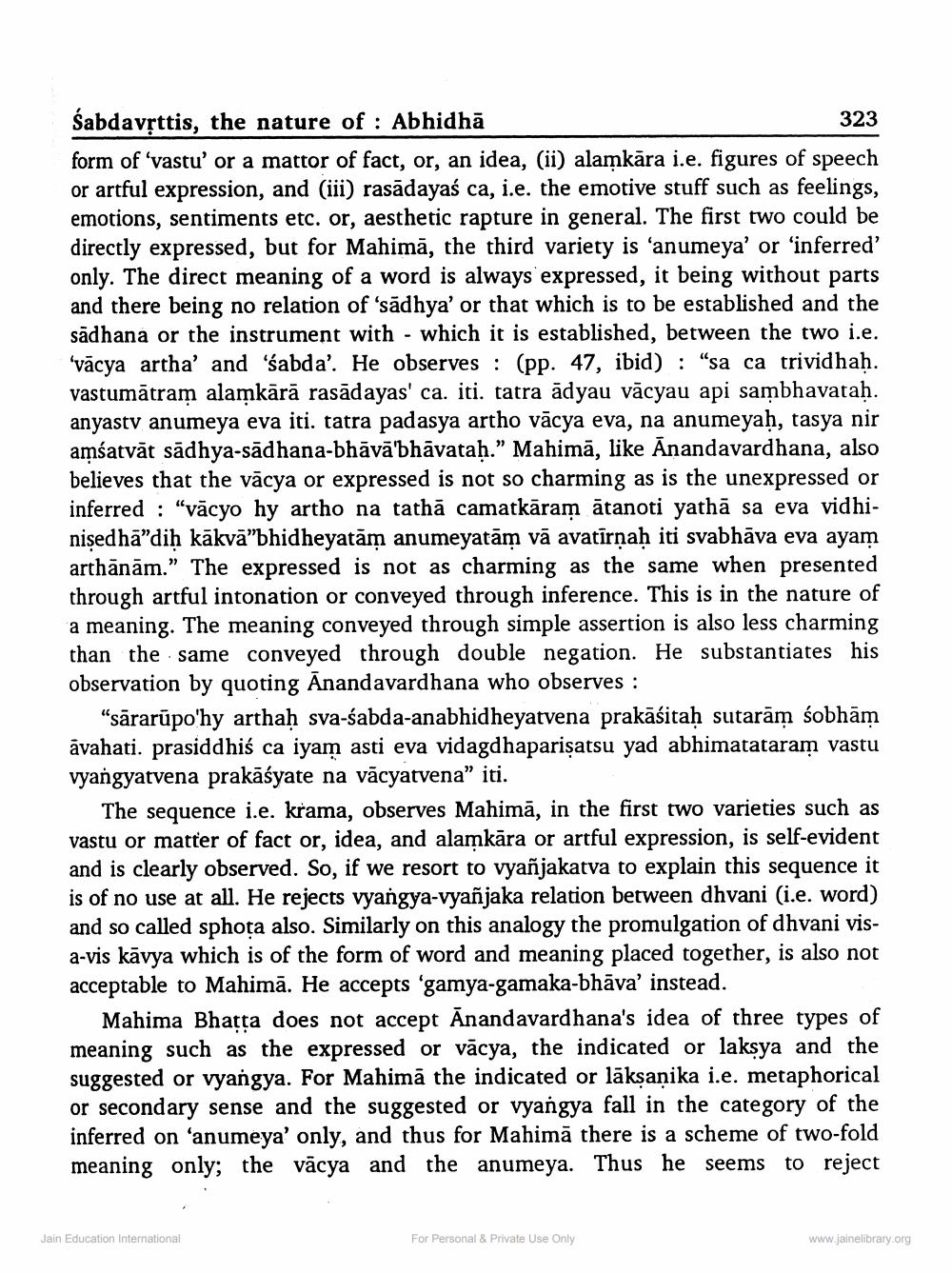________________
Śabdavrttis, the nature of : Abhidhā
323 form of 'vastu' or a mattor of fact, or, an idea, (ii) alamkāra i.e. figures of speech or artful expression, and (iii) rasādayaś ca, i.e. the emotive stuff such as feelings, emotions, sentiments etc. or, aesthetic rapture in general. The first two could be directly expressed, but for Mahimā, the third variety is 'anumeya' or 'inferred' only. The direct meaning of a word is always expressed, it being without parts and there being no relation of 'sādhya' or that which is to be established and the sādhana or the instrument with - which it is established, between the two i.e. 'vācya artha' and 'sabda'. He observes : (pp. 47, ibid) : “sa ca trividhaḥ. vastumātram alamkārā rasādayas' ca. iti. tatra ādyau vācyau api sambhavatah. anyastv anumeya eva iti. tatra padasya artho vācya eva, na anumeyah, tasya nir aņśatvāt sādhya-sādhana-bhāvā'bhāvataḥ.” Mahimā, like Anandavardhana, also believes that the vācya or expressed is not so charming as is the unexpressed or inferred : "vācyo hy artho na tathā camatkāram ātanoti yathā sa eva vidhinised hä"dih kakvā”bhidheyatām anumeyatām vā avatirnah iti svabhāva eva ayam arthānām.” The expressed is not as charming as the same when presented through artful intonation or conveyed through inference. This is in the nature of a meaning. The meaning conveyed through simple assertion is also less charming than the same conveyed through double negation. He substantiates his observation by quoting Anandavardhana who observes :
"sārarūpo'hy arthaḥ sva-sabda-anabhidheyatvena prakāśitaḥ sutarām śobhām avahati. prasiddhiś ca iyam asti eva vidagdhaparişatsu yad abhimatataram vastu vyangyatvena prakāśyate na vācyatvena” iti.
The sequence i.e. krama, observes Mahimā, in the first two varieties such as vastu or matter of fact or, idea, and alamkāra or artful expression, is self-evident and is clearly observed. So, if we resort to vyañjakatva to explain this sequence it is of no use at all. He rejects vyangya-vyañjaka relation between dhvani (i.e. word) and so called sphota also. Similarly on this analogy the promulgation of dhvani visa-vis kāvya which is of the form of word and meaning placed together, is also not acceptable to Mahimā. He accepts 'gamya-gamaka-bhāva’ instead.
Mahima Bhatta does not accept Anandavardhana's idea of three types of meaning such as the expressed or vācya, the indicated or laksya and the suggested or vyangya. For Mahimā the indicated or lāksanika i.e. metaphorical or secondary sense and the suggested or vyangya fall in the category of the inferred on 'anumeya' only, and thus for Mahim, there is a scheme of two-fold meaning only; the vācya and the anumeya. Thus he seems to reject
Jain Education International
For Personal & Private Use Only
www.jainelibrary.org




